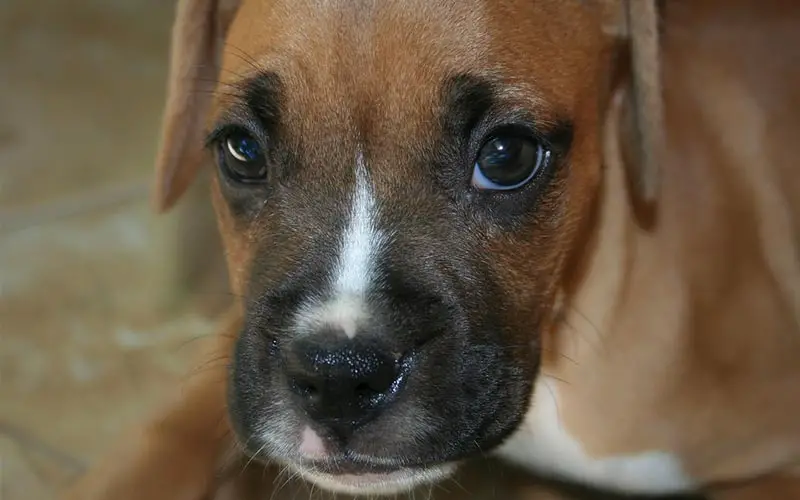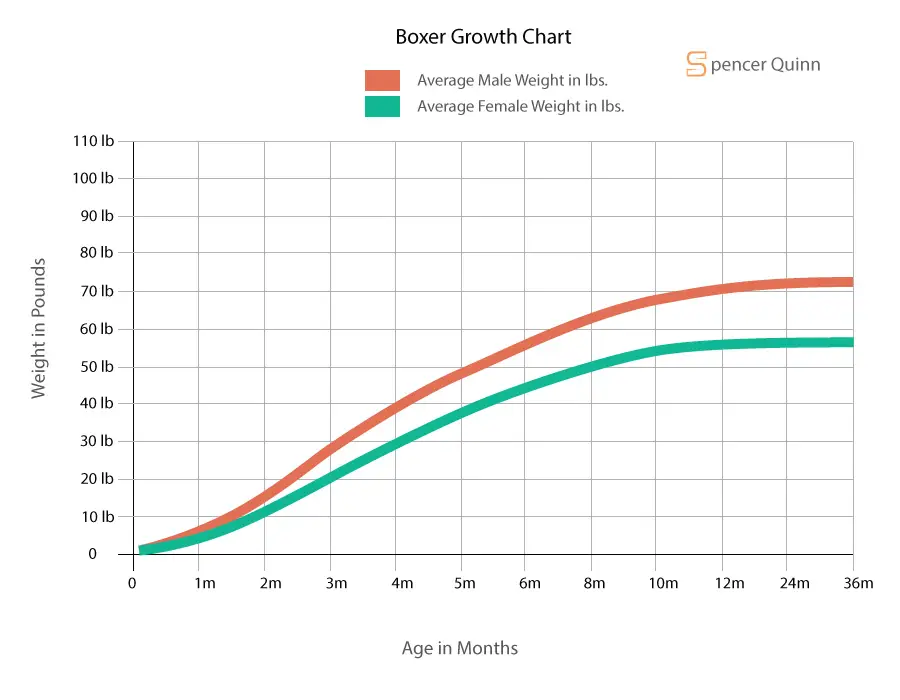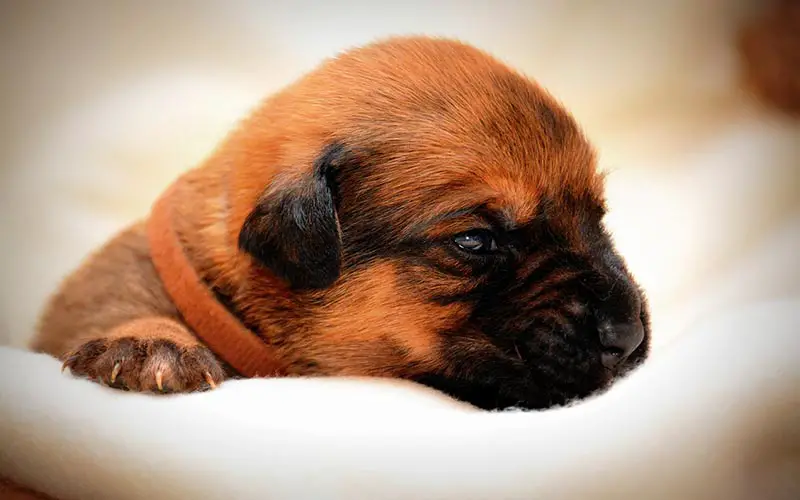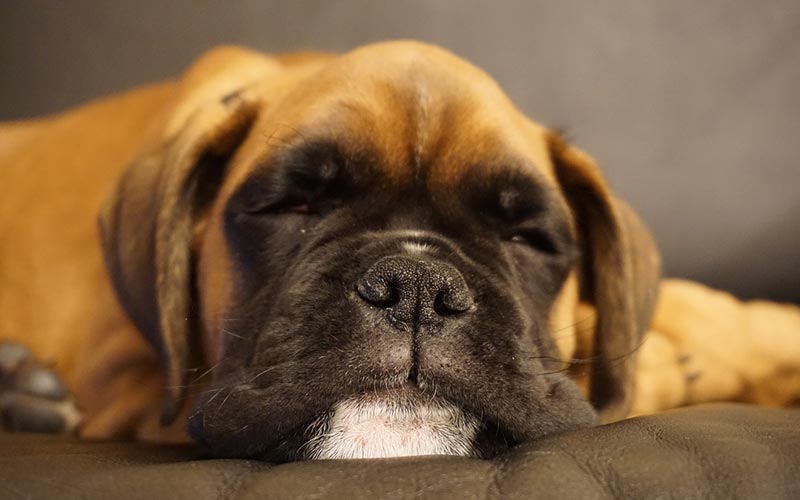When Do You Feed Boxer Puppies

Known for being brave and headstrong dogs, the boxer is a workaholic breed that you've probably seen patrolling with mall security agents. However, beyond the tough and energetic front lies hard work and dedication when it comes to raising them. So, how much do you feed a boxer puppy to keep them healthy?
Becoming familiar with the breed that you want to adopt is important, especially when it comes to preparing food for them. You don't want them to get overweight, underweight, or become more prone to health issues, right?
That's why we wrote this guide for you – to help in feeding your boxer pup the right kind and amount of food. Do keep in mind that boxer pups go through a variety of puppyhood stages, which means that their dietary needs will also differ.
Other factors that will come into play during their development include energy levels, genetics, and the availability of food. So, without further ado, here's a feeding guide for your boxer puppy! We hope that this will help you keep your little buddy happy and healthy in their journey to adulthood and beyond.
Page Contents
- 1 How much to feed a Boxer puppy?
- 2 Feeding Chart
- 3 Growth Chart
- 3.1 Birth to 3 weeks old
- 3.2 4 to 5 weeks old
- 3.3 6 weeks old
- 3.4 8 weeks old
- 3.5 10 weeks old
- 3.6 12 weeks old
- 4 Recommended Food
- 4.1 1. Quality Kibble
- 4.2 2. Wet or canned food
- 4.3 3. Omega fatty acid foods
- 4.4 4. Glucosamine foods
- 5 Foods to Avoid
- 6 FAQs on Feeding a Boxer Puppy
- 7 Raw feeding a Boxer puppy
- 8 Conclusion
How much to feed a Boxer puppy?
As a medium breed, boxer pups generally need to eat at least 3 times a day and their food intake should be about 3 to 4 cups daily. That's because they are working dogs and often use a lot of energy and need to keep their muscles strong.
However, keep in mind that this is only an estimate – boxer pups will need different dietary plans depending on their energy levels, activity, and age bracket. This is especially true if you have multiple boxer puppies in the house.
It's not enough that you feed your boxer pup with a good brand of dog food. You should also consider a proper schedule for them so that they won't get underfed or overfed. We have a guide below for you to get insights on how much to feed boxer puppies depending on their age in weeks or months.
Feeding Chart
So, do you want to know how much and how often to feed your boxer puppy based on their age? We've compiled a chart below just for you:
| Boxer puppy age | Number of daily meals | Total food per day (in cups) |
|---|---|---|
| 2 to 3 months | 3 to 4 | 2 to 3 |
| 4 to 6 months | 3 to 4 | 3 to 5 |
| 7 to 9 months | 2 to 3 | 4 to 5 |
| 10 months + | 1 to 3 | 3 to 4 |
As you can see above, boxer pups need a lot of cups per day, which is crucial due to their nature as active dogs. However, you can lessen it if your pup isn't that life throughout the day. If you have trouble keeping up with the schedule, you can have an automatic feeder or hire someone to feed them.
By sticking to a feeding schedule, not only will your boxer pup get the right nutrients for their daily energy needs and overall health but they'll also be less prone to diseases such as hip dysplasia and cancers – both of which are known to be common among boxers.
Growth Chart
Knowing a boxer's ideal weight depending on their age and gender is important to make sure that they're not overweight or underfed. Here's a chart that will give you rough estimates of typical boxer puppy weights:
| Age in Month | Male Weight | Female Weight |
|---|---|---|
| 1 month | 6-7 lbs (2.7-3 kg) | 5-6 lbs (2.3-2.7 kg) |
| 2 months | 15-17 lbs (7-7.7 kg) | 12-15 lbs (5.5-6.5 kg) |
| 3 months | 25-28 lbs (11-13 kg) | 20-25 lbs (9-11 kg) |
| 4 months | 35-42 lbs (16-19 kg) | 28-35 lbs (13-16 kg) |
| 5 months | 43-52 lbs (19-24 kg) | 35-43 lbs (16-19 kg) |
| 6 months | 50-60 lbs (23-27 kg) | 40-50 lbs (18-23 kg) |
| 8 months | 59-70 lbs (26-31 kg) | 45-58 lbs (20-26 kg) |
| 10 months | 63-75 lbs (28-34 kg) | 48-62 lbs (22-28 kg) |
| 12 months | 65-78 lbs (29-35 kg) | 50-63 lbs (23-28 kg) |
| 24 months | 65-80 lbs (29-36 kg) | 50-65 lbs (23-29 kg) |

Typically, boxer puppies around 6 months of age would probably be almost at their adulthood, since they grow fast. Male boxer puppies would be around 17 inches or more during their 6th month while females will be slightly smaller at around 16 inches.
For a more detailed breakdown of what to expect during your boxer puppy's journey from being a youngster to adolescence, we have guides for you below.
Birth to 3 weeks old
When your boxer pup is still very young, they should be with their mom and be nursed properly. As with humans, puppies need their basic nutrition coming from their mother's milk. Keep in mind that your boxer should get equal amounts of milk, especially if they belong to a large litter.
Observe the litter for any signs of bullying or some puppies being overpowered. If for some reason, one of the puppies looks slightly thinner than the rest, you can ask your vet for puppy formulas to supplement the mother's milk. This is also the case if the mother is too thin to supply milk to all of her pups.
When your puppy reaches 3 weeks of age, you might start to notice rapid growth. That is normal for boxer puppies since the breed tends to grow faster than most dogs. Boxer pups of this age still need to be nursed.
4 to 5 weeks old
By the 4th week, your puppy can be introduced slowly to solid food. To do this mix 1 part puppy food with 3 parts water in a bowl and offer it to them. Don't start with a heap of content because there is a big chance that they might refuse it at first!
Take your time into offering it but don't let it spoil. Ideally, serve it to them and take it out if not eaten within 10 to 20 minutes to avoid spoiling the nutrients and making your puppy's tummy go bad. It also helps to train your pups to only eat when they are hungry.
A good rule of thumb in terms of scheduling for the water and puppy food mixture would be 3 to 4 times a day. Don't force your pup to feed on it because weaning takes time and patience. You want the process to be a pleasant one for your boxer pup.
Within the puppy's 4th and 5th week, you will still see them getting nursed by their mother, albeit slowly drifting away. This is when the weaning process becomes slightly visible. The mother dog will slightly let go of her little ones for them to be independent.
What's more, since you are already training them to eat solid food using the mixture, they will become more interested in eating it. Either way, you're doing a great job because the mother dog, by this time, will eventually find it uncomfortable to nurse.
Milk teeth should also appear during the boxer pup's 5th week, which is when they will start chewing on items as well. Keep them away from dangerous objects and supervise them as much as possible. Ensure that their food is easy to chew to avoid eating problems.

6 weeks old
When your boxer pup reaches 6 weeks of age, you can slowly increase the food offering to about 4 times a day. Likewise, this is time to start reducing the water content so that it's half-and-half for both the liquid and the solid content.
Eventually, when your puppy begins to like chewing down the food, you can just stick to 1/4 water. This will help slowly train your pup to eat their solid dog/puppy food with great ease. If your vet allows for it, you can add some veggies or other food ingredients that are deemed safe for pups as advised.
Your puppy will need more nutrition by this time so they need to learn to eat solid puppy food. After all, 6 weeks old is a time for exploration, playtime, and energy bursts (whether indoors or outdoors). You may also want to feed them more if they spend a lot more time playing or running around.
Once your puppy reaches 7 weeks old, they should already know how to eat their solid food. Give them the serving somewhere between 3 and 4 times a day depending on your available time and their hunger pangs.
Your boxer pups will also get nursed less often during this time, as the mother will likely just stand up while giving milk (reluctantly) to her little ones. She might even run away from them at some point, allowing them to become more independent.
8 weeks old
The weaning process should be finished by 8 weeks of age, which is the perfect time for boxer pups to be adopted and re-homed. Keep their meals served at 3 to 4 times a day, with at least 2 or more cups per day, divided equally.
You can also follow the chart that we mentioned above, especially if your boxer pup is quite the active fellow. Having more cups a day is important for puppies that have far less weight than others. With that said, feel free to adjust depending on your puppy's needs or as advised by your vet.
You can also ask your vet about how many calories they need depending on their energy levels. After all, too many calories in food will cause obesity if your puppy isn't too active. Keep an eye out on puppy food that's filled with unnecessary fillers and stick instead to meaty proteins, if possible.
10 weeks old
Don't be surprised if your boxer puppy becomes a voracious eater during their 10th week – this is perfectly normal because of their growth spurt. You might want to restock a lot of puppy food (maybe even more than your adult boxer's daily diet).
Know the activity levels of your puppy and adjust accordingly. If your boxer pup is always on the go, they might need more calories than usual. Moreover, a 9-week-old boxer pup might also roam around and pick various objects to ensure that their surroundings are kept puppy-proofed.
If your puppy is prone to bloating, consider feeding them 4 times a day so they don't get too hungry in between. Bloating comes from excessively gobbling food so make sure they only get equal portions for their daily meal schedules.
While we did say that boxer pups during this period are likely to eat twice as much as a regular adult boxer, always observe if your puppy is getting overweight by checking their waist. Talk to your vet if you suspect your pup might be gaining too many pounds.
12 weeks old
At 12 weeks of age, your puppy should stick to a 3-meal course per day and should already be doing well with kibble. Always keep in mind to avoid bloating problems with your pup by ensuring the schedule gets followed.
Continue with the usual puppy food or as instructed by your vet. Eventually, you can switch them to adult food once they've reached 1 year of age.

Recommended Food
Now that your boxer puppy has a set schedule, what should you feed them? Here are some suggestions:
1. Quality Kibble
Like most active breeds, dry kibble is the way to go if you want affordable and easy-to-store food for your boxer puppy. Crunchy kibble will help develop your puppy's teeth to become stronger. However, keep in mind that you should know what goes inside your puppy's bowl in terms of ingredients.
Look for a puppy food that's rich in omega fatty acids because boxers are likely to catch skin problems if they are fed with the wrong type of food. Other than that, fillers such as corn and soy aren't good for their skin either. Worry not – there are grain-free options in the market.
2. Wet or canned food
If you want added calories for an active boxer puppy, consider wet food. After all, canned puppy food is tasty to most dogs, especially during their puppy years, since the smell is enough to get them eating. However, keep an eye out for their weight and don't give them too much if they aren't running around too often.
We prefer mixing wet and dry food so your puppy's dental health isn't overlooked. By combining kibble and wet food, you're providing a crunchy and palatable meal for your puppy without compromising on the nutrients.
3. Omega fatty acid foods
Boxers are prone to cardiomyopathy, which can be lessened if they take foods and supplements rich in omega fatty acids, such as fish. Talk to your vet for a diet plan that will help lessen the likelihood of such eye problems.
4. Glucosamine foods
Hip dysplasia is common in boxers so we recommend foods that are rich in glucosamine, such as chicken feet and seafood. Consider looking for either kibble or canned puppy food that has glucosamine to help prevent hip dysplasia and other joint problems.
Foods to Avoid
Generally, you'll only want to avoid foods that have fillers and preservatives, especially since boxers are prone to tummy upsets and skin allergies. Look for primarily meat-based puppy food rather than cheap commercial brands.
Commercial brands out there may have more corn and wheat than protein from meat. That's not good for your puppy because it only gives them bulk and not nutrition. Instead, look for slightly pricier yet more quality brands of puppy food for your boxer.
And, as usual, you should also stay away from human foods that are toxic to dogs, such as grapes, chocolate, caffeine, alcohol, artificial sweeteners, and the like.
FAQs on Feeding a Boxer Puppy
Boxer pups need extra care when it comes to their diet – here are some frequently asked questions with regards to feeding them properly:
When do I switch to adult food for my Boxer puppy?
Boxers mature when they are about 18 months old or 1 1/2 years old. By this time, you can slowly transition your puppy to adult food in portions. Make the portion changes every 5 days to avoid shocking your puppy's digestive system.
Should I give my Boxer puppy supplements?
As a workaholic dog breed, boxer pups need protein and other nutrients, which are fortunately already in most quality dog food brands. If your vet didn't advise on supplements then there's no need to give your puppy some – too many nutrients could even ruin their health!
Raw feeding a Boxer puppy
A raw diet is okay for boxer puppies provided that you get expert advice from your vet about it. Raw feeding is no walk in the park since you need to do the math on calories and nutrients as compared to commercial food.
Also, take note of food handling to avoid bacterial infection, especially if you live in areas where humidity is high. If you need help, talk to a breeder or someone you know tried raw feeding before – especially for puppies.
Conclusion
A healthy and energetic boxer puppy will be a satisfied life companion if you feed them properly. All you need to know is that boxers are typically workaholics so they need to have a balanced diet with sufficient calories based on their activities. We hope this helped you figure out how much to feed your boxer puppy!
orbisonforebole88.blogspot.com
Source: https://spencequinn.com/boxer-puppy-feeding/
0 Response to "When Do You Feed Boxer Puppies"
Post a Comment